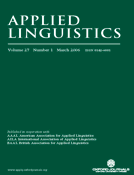-
Views
-
Cite
Cite
Nancy H. Hornberger, A. Suresh Canagarajah (ed.): Reclaiming the Local in Language Policy and Practice. Lawrence Erlbaum, 2005., Applied Linguistics, Volume 27, Issue 1, March 2006, Pages 142–145, https://doi.org/10.1093/applin/ami043
Close - Share Icon Share
Extract
Local knowledges, local identities, local languages, local practices, local literacies, local standards, local demands, local experiences, folk wisdom, and native representations are among the things local being reclaimed in the pages of this edited volume. As documented and illustrated here, the local is multiple and diverse (p. 12), continuously evolving and negotiated (p. 13), contested and hybrid, riddled with internal contradictions (p. 109), and enmeshed in global politics and transnational movements of people and labor (p. 282). From multilingual settings in Sri Lanka, Brunei, Malaysia, Iran, China, Japan, Hong Kong, India, Brazil, Britain, and the United States, we hear (read) local voices expressing themselves in local varieties of English, in Dominican and Mexican varieties of Spanish, as well as in Cajun French, Portuguese, Kashinawá, Malay, Iban, Cantonese, and others.
The authors in this volume draw on an array of complex theoretical stances, taking care to define and situate them in locally relevant ways. In the footnotes alone, one finds brief and succinct definitions of terms such as hegemony and homogeny (p. 26), naturalize and essentialize (p. 29), linguistic capital and linguistic marketplace (p. 35), ambilingualism (p. 31), subtractive bilingualism (p. 34), graphocentrism (p. 76), multimodality (p. 77), and glocal (p. 199); while other clarifications crop up throughout the chapters, for example border thinking (p. 73), discursive construction of identity (p. 168), hybridity (p. 186), and glocalization (p. 217). The volume's editor, A. S. Canagarajah, in his two informative opening chapters, provides extensive conceptual orientation and discussion, including summary charts which depict recent and ongoing shifts in English language teaching pedagogical practice and professional discourse.



